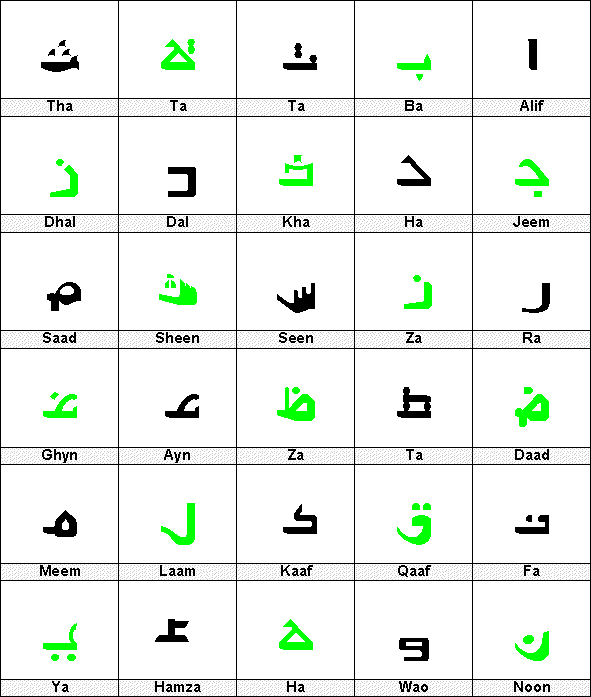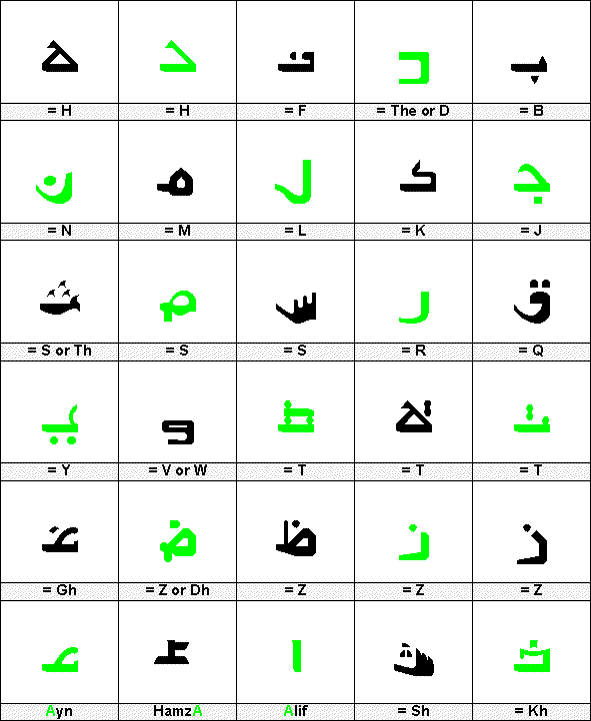|
NAZRA Quran
Please read on, for extra useful information.
1: A Brief for Teachers and Current Readers of Holy Quran
About 'Easy Recite Arabic Transliteration'
All teachers and former readers of the Holy Quran already know all 'Rules of Recitation' and the 3-5 symbols per
Arabic letter, etc. Their expertise is welcome in 'ERA' System. However, a few variations / exceptions, as under,
may please be noted.
- A hollow letter is a non-spoken letter. It gives no sound. It is to be neglected, ignored and not be read.
- A hollow 'Harakah' is non-effective. It is neglected, ignored and not taken into account.
- A green letter signals to be the first letter of a 'Pair of letters, to be read, blended together.' All green
letters are blended to next spoken letter, which is either black or green and carries a 'Jazm' or a
'Shadda' on it.
- A green 'Harakah' also tells that a pair of letters starts from this green letter.
Note: In other scripts, 'a Jazm or a Shadda' is found on the 'second or last
letter' in each 'Pairs of joined Letters.' In ERA System the first letter of all such pairs is shown in Green.
Thus, ERA shows a 'green light' to start each Pair.' ERA displays 'Jazm or Shadda', as a convention.
Remember: 'Green color always starts a pair.'
- A black letter does not start any pair of letters. It speaks, either as a single (individual) spoken letter or
as a second letter in a pair of blended letters.
- A black 'Harakah' affects its own associated black letter and no more.
- The black or green portion of a partially hollow 'Harakah' performs, as per its own color.
- ERA System, in total, uses just 30 Alphabetic symbols to reproduce and type whole of Holy Quran and all
sorts of Arabic. First, look at them carefully.
With a focus on above mentioned variations, you shall be pleased with your results. Not only, you shall
improve the quality and fluency of your own recitation, get motivated to
teach and tutor others, but also succeed to memorise
more portions from the Holy Quran. Insha Allah.
2: In ERA Transliteration, only 30 Symbols are used, instead of ~ 120
3: Basic Sounds of Arabic letters, shown in English sequence.
4: Contrast of NAZRA Skills, using Old text and ERA Transliteration.
[As Required by Learners, Readers and Teachers]
| Old Skills |
New (ERA Transliteration) Skills |
Skill #1
To learn, remember and work with 120-150 shapes or symbols, depicting 28 Arabic alphabet,
during their recitation activities. |
Skill # 1
To learn, remember and work with only 30 shapes or symbols, depicting 28 Arabic alphabet,
during your recitation activities. |
Skill # 2
To differentiate between many mutually similar letter symbols of Arabic alphabets. |
Skill # 2
Not required.
ERA letter symbols are not much alike. Each letter
is distinct and unique in its showing. Even 'nukta' or dots differ. |
Skill # 3
To surf and search 1-5 spaces ahead of each letter under recitation, in same line or next line, on same
page or next page, on same side or opposite side of the page in view, to find the presence / non-presence
of a 'Black jazm' amid black letters and black 'Irab' of the text. |
Skill # 3
Not required equally.
ERA System uses 'Red jazm' in place of 'Black jazm.'
Like a red traffic light on a road, each 'Red jazm' stands out more easily
and quickly. Therefore, old skill to surf and search 1-5 spaces ahead of each letter is not required, exactly. |
Skill # 4
To learn, remember and practice many rules to find out 'Silent or non-spoken letters' in Arabic text.
After finding out each silent letter, it is ignored by readers during their recitation. |
Skill # 4
Not required.
Because, ERA System finds out all the 'Silent or non-spoken letters' and displays them in hollow or
transparent format.
Hollow letters are then ignored by the readers. |
Skill # 5
To learn and practice methods and means to distinguish between two types of spoken letters.
One, whose affected-sound joins or blends with the next letter, having a jazm or shadda on it, and the
second type of letters, which do not join or blend with next letter. |
Skill # 5
Not required.
ERA System no longer requires its users to bother about two types of spoken letters. ERA System segregates
both types in entire Arabic Holy Quran and prints them in Green and Black colours.
Green letters join or blend with next letter. Black letters do not join or blend. |
Skill # 6
To learn too many names, their abbreviated Arabic representations and their puzzling functions as Arabic
Punctuation Signs, known as 'Waqoof.' |
Skill # 6
Not required equally.
ERA System uses only one sign, round in shape. It shows the end of each 'Ayah' and it counts serial
numbering and quantity of 'Ayahs' in each 'Surah.' |
Skill # 7
To learn the influences and effects of too many Arabic 'Waqoof' Signs on former 1-2 letters and their
diacritics. Instead of actual visible Arabic text, the readers have to read or recite their decoded effects. |
Skill # 7
Not required.
All effects and changes on former 1-2 letters and their diacritics are fully shown by ERA System in wise colours.
Therefore, all readers read and recite actual visible Arabic text, as seen by them.
Readers are not required to decode effect or influence of Arabic 'Waqoof.'
Such Smart Solutions were never ever available to readers, in the past. |
Skill # 8
To learn and remember all reasons and arguments, as to how and when to recite a 'Noon' 100%, 50% or 0%. |
Skill # 8
Not required.
ERA System saves its readers from all reasons, arguments labour and liability.
ERA displays the 'Noon' 100%, 50% or 0%, as to be recited by readers. |
Skill # 9
To learn, remember and practice, when to apply a 'Fatha, Dhama' or 'Kasra' to an 'Empty Alif,'
to start a fresh recitation from that 'Empty Alif.' |
Skill # 9
Not required.
ERA System shows a 'Fatha, Dhama' or 'Kasra' in red colour,
before relevant 'Empty Alif,' as an aid to all its readers. |
Skill # 10
To be trained to repeatedly pre-scan the text on next line, while still reading the text on former line,
to detect, if two letters on these two lines are to be blended together or not? It is required far about 3,000
times in a Holy Quran. The readers either forget to blend at proper times or strive to blend at wrong places.
Both actions create errors! |
Skill # 10
Not required.
ERA System ensures that all such chances are totally eliminated, except at 2 locations only, where a warning exists.
As a result, all readers are utterly relaxed during their recitation of entire Holy Quran. |
Some Sample Pages of Holy Quran
Please visit following actual pages from New ERA NAZRA Quran
 |
Buy an E-book copy of New ERA NAZRA Quran for $ 4.99 only.
Click Here
|
Note: In case you rightly deserve a discount, then please study all Web-Pages including Library & FAQs, before informing us, as to how ERA Transliteration can facilitate your Sacred Services to the Holy Quran? We shall try to help you, to our maximum, For Free. In Shah Allah.
Please contact us at: smk@EasyReciteArabic.org
|
|










